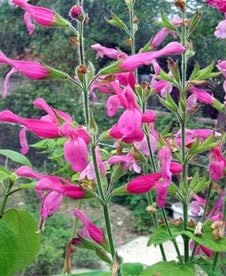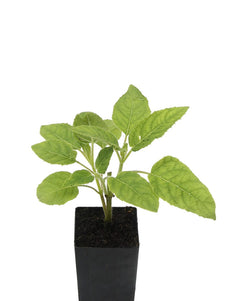





Salvia dorisiana 'Fruity Sage'
Salvia dorisiana 'Fruity Sage'

- Low stock - 8 items left
- Inventory on the way

Usually available: All year
Life cycle: Perennial
Height: 1.3m
Position: Full sun
Soil preference: Well drained
This is how we pack and send your Herb Plants to all states except TAS & WA
You will receive
- 1 Fruity Sage Herb Plant in a 50 X 75mm tube - General growing instructions
All of our Herb Plants are grown organically with certified organic potting mixes and fertilizers
Botanical Name: Salvia dorisiana
Fruity Sage is an evergreen perennial under the right climatic conditions, although in some regions it may die down and return in spring. The plant has an upright branching habit, but the branches may have a slightly drooping quality. It grows to about 1.3 meters and 50-60cm wide. The fuzzy, vibrant lime green leaves are heart or ovate shaped, with deep veins and serrulate margins. They are positioned alternately along the stem. The flowers are quite large, lipped and are a strong magenta pink colour with green calyces.
Fruity Sage is known for its intoxicating fragrance, which has been described as reminiscent of many fruits! It may go by the name peach sage, fruit scented sage, fruit cocktail sage or even grapefruit sage in some parts of the world. The leaves, as well as much of the plant, are covered in tiny hairs, giving an overall fuzzy appearance, which release oils when crushed or brushed against in the garden. If you are in need of a comparison, it has also been likened to a sweeter version of Pineapple Sage (Salvia elegans).
There is some confusion about how Fruity Sage came by its scientific name. Many websites claim that the plant was given its name in honour of the mythological Greek Titans. The common claim is that the name ‘dorisiana’ acknowledges Doris, the daughter of Oceanus and Tethys. She became the wife of Nereus the ocean river god and together they parented 50 sea nymphs. However, the more mundane reality is that the plant was first described in 1950 by Paul Carpenter Standly. The plant is native to Honduras and the botanical name refers to Doris Zemmurray Stone (1909-1994) who was an archaeologist, ethnographer and Director of the National Museum of Costa Rica.
In its native environment, this plant is adored by hummingbirds. Like many salvias, it will probably also add some bird, butterfly and bee attractant qualities to your garden.
Some culinary uses for Fruity Sage include using the leaves and flowers in salads, fruits salads, iced teas and fruit punches. The dried leaves retain the fragrance and also make very nice wreaths and potpourri.
Growing Conditions
Fruity sage prefers to grow in moist, well draining soil with a preference for rich, sandy loam. Although the plant will have some degree of drought tolerance, it should be watered well in summer. It will tolerate partial shade, but like most salvias, fruity sage prefers a full sun aspect. In areas where there is heavy frost or if there is limited space, Fruity Sage may be grown successfully in garden containers.
This salvia is known to be very hardy and is cold tolerant to 1 or 2 degrees Celsius. When frosts occur, the plant will bounce back with new growth from the base in spring. It is also appropriate to cut the stems back after flowering or simply to restrict growth when necessary. Fruity Sage may be propagated by cuttings taken at the right time of the year.
The salvia family has over 900 members with an extensive history as culinary, medicinal and ornamental plants. Ornamental salvias have become collectors items, as gardeners try to find a place in their garden for each and every one. There are salvias that will suit every type of soil and climate. More information on the Salvia genus and Common Sage (Salvia officinalis) may be found on our Common Sage page.
All information provided on this website is for informational purposes only. Please seek professional advice before commencing any treatment.





